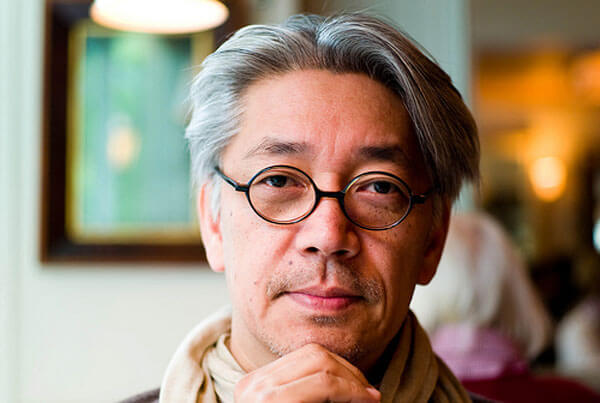 Composer and alto saxophonist John Zorn, known to me mostly as the founder of East Village not-for-profit performance space The Stone, and as the producer of funk-metal band Mr. Bungle’s eponymous album, visited the Japan Society in New YorkCity on October 4, 2013, for an evening of improvisatory collaboration with Ryuichi Sakamoto, Academy and Grammy award-winning composer and musician (on prepared piano). The venue was a fitting one for a Zorn@60 celebration, as Zorn maintained a home in Tokyo for a decade, absorbing Japanese culture. The evening commemorated his kanreki, or 60th birthday, a special milestone of longevity and renewal in Japanese tradition, and a temporal launching pad for future creative endeavors.
Composer and alto saxophonist John Zorn, known to me mostly as the founder of East Village not-for-profit performance space The Stone, and as the producer of funk-metal band Mr. Bungle’s eponymous album, visited the Japan Society in New YorkCity on October 4, 2013, for an evening of improvisatory collaboration with Ryuichi Sakamoto, Academy and Grammy award-winning composer and musician (on prepared piano). The venue was a fitting one for a Zorn@60 celebration, as Zorn maintained a home in Tokyo for a decade, absorbing Japanese culture. The evening commemorated his kanreki, or 60th birthday, a special milestone of longevity and renewal in Japanese tradition, and a temporal launching pad for future creative endeavors.

Sakamoto-san caressed the piano wires with a variety of implements and surfaces, creating a buzz and hum made somewhat more penetrating by amplification. Zorn joined with very Mannerist sound-sculptures; imagine time-lapse video of bamboo growing, burning, battered by wind ,and quietly surviving. At one point the musical conspiracy encountered David Lynch on the lost highway, buried him up to his head in the blue sand and whispered sweet nothings into his sick, greasy hair.
Zorn, in loose-fitting camouflage pants, kept his left foot up on a folding chair, to be able to pivot his sax and mute it against his thigh, the spirit maintaining a gripping voice through repeated bouts of strangulation. The meditation was light-heartedly interrupted as he emptied about a half-pint of spit from his sax, the audience chuckled and he looked up suggestively at us, eliminating the distance between cerebral detachment and humor. He soon resumed with a squeaking, reed-sucking kiss-marathon (with us? with the piano?).

Sakamoto, having spent much time standing hunched over the fallboard, tinkering like a pathologist with the exposed vocal chords of a chanteuse, sat down and constructed an atom whose nucleus was the sadly insistent B-flat of Gaspard’s Le Gibet, and whose tentative electrons approached and scurried away nearby on the keys. Zorn joined in, sending one pure tone out to the cosmos. Distant piano, Sakamoto’s back still hunched, head now hung over the keyboard, resonance stifled, the space shrunk to what’s inside my skull. Ornette Coleman Hawkins stopped by for a drink and I failed to look up from the feet of the woman sitting next to me. The saxophone was pestering a lover already long-exhausted. I though I heard another quotation from the sax, this one the frenetic episode from late in Rhapsody in Blue.
Sympathetic vibrations of piano wire, and Zorn’s virtuosic yet unstudied runs on the sax, helped me recall the work of other artists who have left indelible impressions — John Carpenter, Kahlil Gibran — the horror and the love. It is very interesting, and strangely both disorienting and comforting, that sitting stationary in a theater can give one the impression of traveling vast distances. Zorn and Sakamoto seemed to rush eastward through the currents of the Pacific, encountering no resistance, hounding radioactive molecules from Fukushima and trying patiently to exorcise the spirit of dark technology before it made landfall in the Americas.
What stories do the tefillin tell? A mystery. Also a mystery: no one ever sings happy birthday in tune.
























